In the midst of a pandemic that’s led to unprecedented levels of remote working, digital tools to monitor employees in real time are gaining popularity among companies looking for new ways to track employee productivity. At the same time, the trend raises concerns about employee privacy and how far companies should be allowed to go to keep tabs on their workers.
Applications such as StaffCop, Teramind, Hubstaff, CleverControl, and Time Doctor include real-time activity tracking, can take screenshots of workers’ computers at regular intervals, do keystroke logging, and record screens. In some cases, the tracking tools can be installed without the knowledge of employees. Companies say they’re focused on transparency and productivity, but privacy groups decry draconian “Big Brother” moves made possible by technology. (Computerworld reached out to several of the vendors for comment; they either did not return messages or could not provide someone to discuss their software.)
As COVID-19 spread earlier this year, forcing workers out of the office and into ad hoc work-from-home setups, the installation of tracking software on employee devices “dramatically accelerated,” said Brian Kropp, group vice president for Gartner’s HR practice.
“When COVID-19 hit, we found that within the first month, 16% of companies put new tracking software on the laptops of their remote employees,” said Kropp, who has done research on post-COVID-19 workplace trends. By July, the number had risen to 26% of companies.
“We were already moving in this direction of passively monitoring our employees, listening to them and watching them, and asking them less and less,” said Kropp. “What the pandemic has done is just accelerate the speed at which that is happening... They were going to get there eventually; the pandemic has just accelerated the future into the present.”
Phoebe Moore, associate professor of Political Economy and Technology at Leicester University in the UK, echoed Kropp and sees potential privacy concerns for employees.
“Frankly, yes, it is on the rise,” said Moore, who is working on a research project involving workplace surveillance for the EU Parliament. “Whether or not it's necessary is another question, but it's definitely happening. There's a lot of new purchases in this software arena, a lot of new investment, a lot of new experimentations. And I think this is a bit of a shift to these at times invasive practices.”
Employee monitoring: How we got here
Employee monitoring to improve efficiency is not new, with conflicts over what should be prioritized: the rights of employers to see what their workforce is doing or an employee’s right to privacy and autonomy.
Keeping an eye on employees pre-dates the information age; companies have long gravitated toward efforts to boost economic efficiency through worker productivity, a key tenet being the close monitoring of workers to hone and fine-tune work processes.
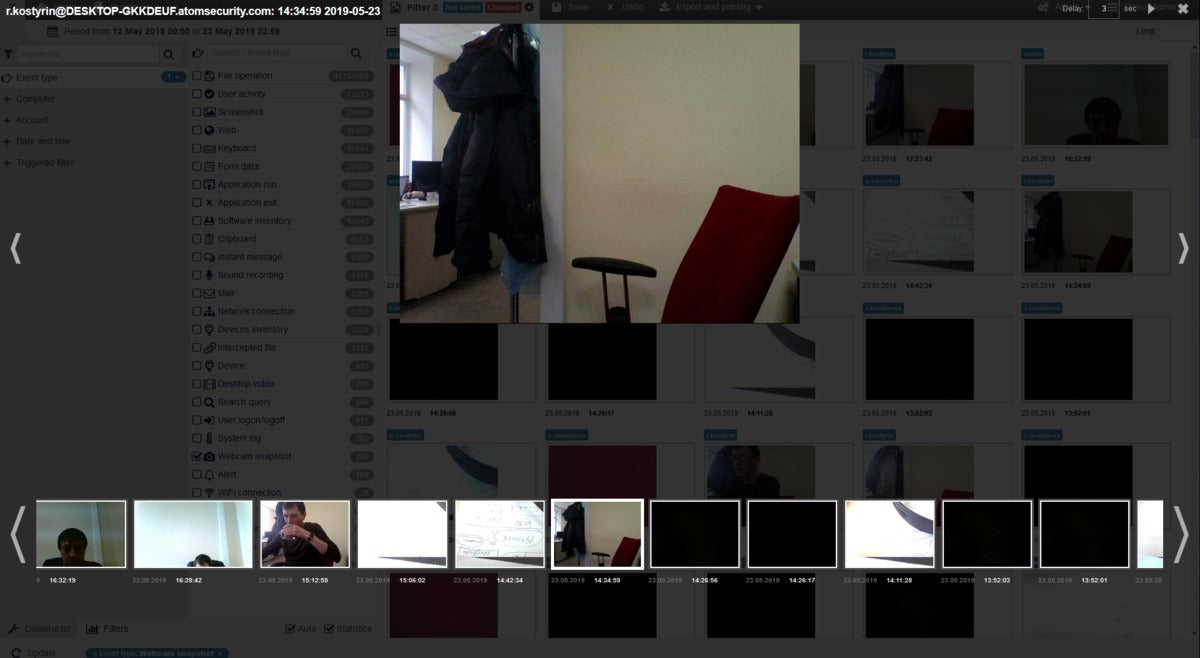 StaffCop
StaffCop
StaffCop lets admins monitor employees via live video feed using their computer’s webcam.
While often effective — the assembly lines at Ford factories a century ago are a notable example — the approach has also proved controversial because it can increase worker stress. In recent decades, as work shifted from the industrial to the information age, techniques to track employees evolved with new technologies.
The trend has been evident in jobs that require physical work, such as in manufacturing and warehouses. Amazon, for example, has drawn scrutiny for its automated tracking of fulfilment center workers, with reports of firings based on the productivity metrics gathered.
White-collar jobs are monitored as well; the recording of internet history, email messages and location have been done for many years. A 2007 survey by the American Management Association showed that 66% of employers monitored internet connections; 45% tracked keystrokes; content and time spent at the computer; 43% stored and reviewed computer files; and 10% even monitored employee social media accounts.
“Every single industry has some form of identification of workers’ activity,” said Moore. “The difference now is maybe you could ask the question of which industries are using [it] more, and which industries are under the spotlight. Whereas once upon a time a manager stood with a clipboard and kept track of what people were doing on the shop floor, now you're seeing this in the office space, where every time you use a digital platform there's data that's being gathered about you.”
More advanced software now allows companies to build a picture of the internal workforce faster and in more detail. A 2018 Gartner survey of 239 large corporations found that more than 50% were using some type of “non-traditional monitoring techniques” such as email monitoring and location analysis, up from 30% that did so in 2015. The expectation at the time was that that figure would reach 80% by 2020.
“What we saw beginning to occur about four years or so ago are companies experimenting with new technologies to track and understand their employees,” said Kropp. “We've seen companies monitoring employees' internal emails and using those to get sentiment analysis. We saw companies using organizational network analysis by examining the calendars of employees to try to understand who they meet with, who are most important people in the company, and so on.”
Despite concerns around privacy, digital employee monitoring has largely become an accepted practice in measuring performance at work — just as the use of fitness trackers to monitor training or daily step counts has become common.
For Human Resources departments, analytics applications can provide performance insights across an organization’s workforce, help identify talent, and offer insights on where employees may need more support.
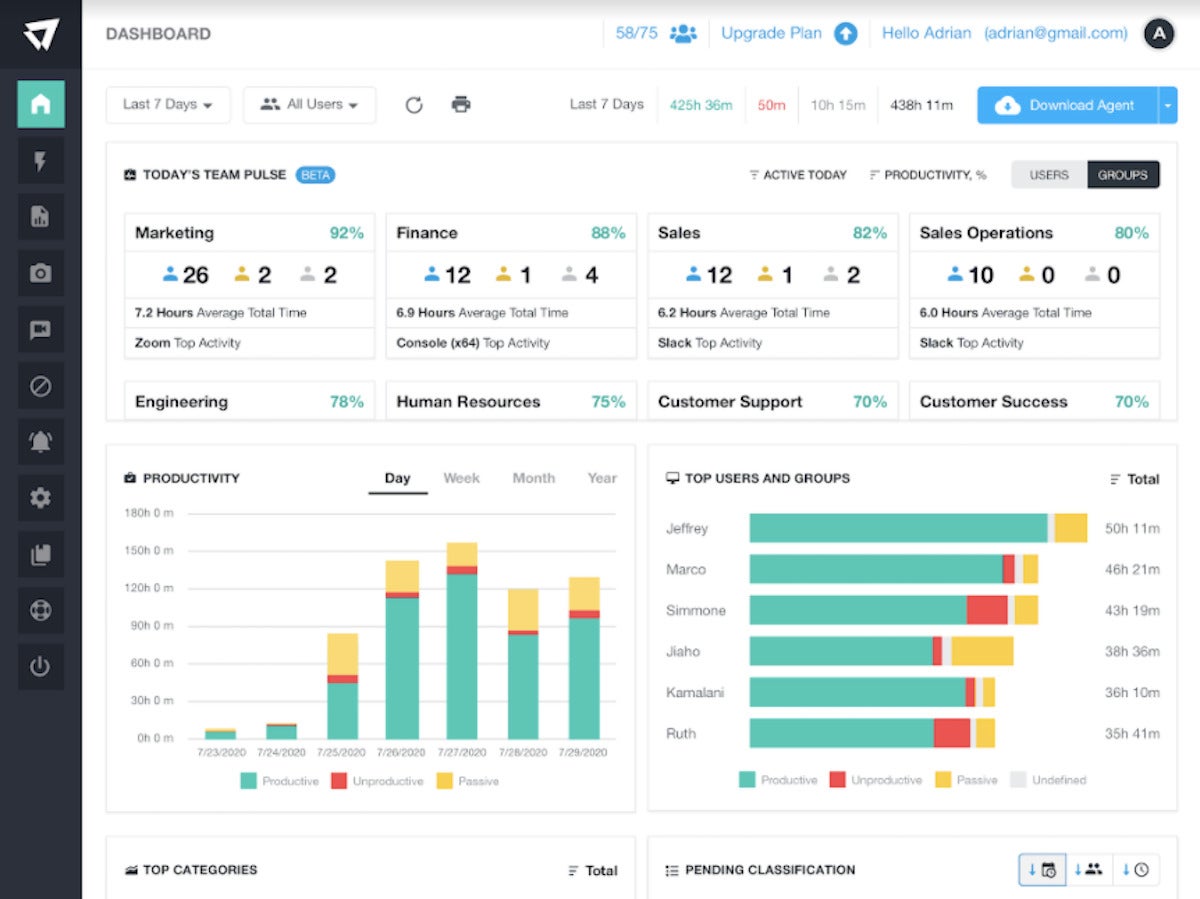 ActivTrak
ActivTrak
ActivTrak gives a detailed breakdown of where employees spend their time, labelling certain apps and websites as productive or unproductive.
Most modern digital productivity tools offer a range of metrics at the team or individual levels. For example, Microsoft, the biggest productivity software vendor, has a dedicated tool for tracking behavior — Workplace Analytics — that is used by the likes of Vodafone and Unilever to tap into Office 365 data, offering behavioral insights such as the number of emails a person sends each day. (Microsoft also has an app, MyAnalytics, that lets individual workers track their own productivity.)
Google’s Work Insights feature provides analytics to track collaboration patterns in Workspace (formerly G Suite) such as time spent in meetings, with an aggregate view of at least 10 workers. And, though not necessarily a gauge of actual productivity, Slack’s analytics can highlight which employees have sent the most messages in a particular time period.
The new breed of monitoring tools
More recently, there has been an uptick in the use of apps that monitor behavior proactively and much more precisely. Dubbed “bossware” by critics, the software has drawn criticism this year as being overly invasive.
Once installed on an employee’s computer, these tools can continuously monitor and record activity at a granular level and record the screens of users. In some cases, it’s possible to do this without an employee’s knowledge.
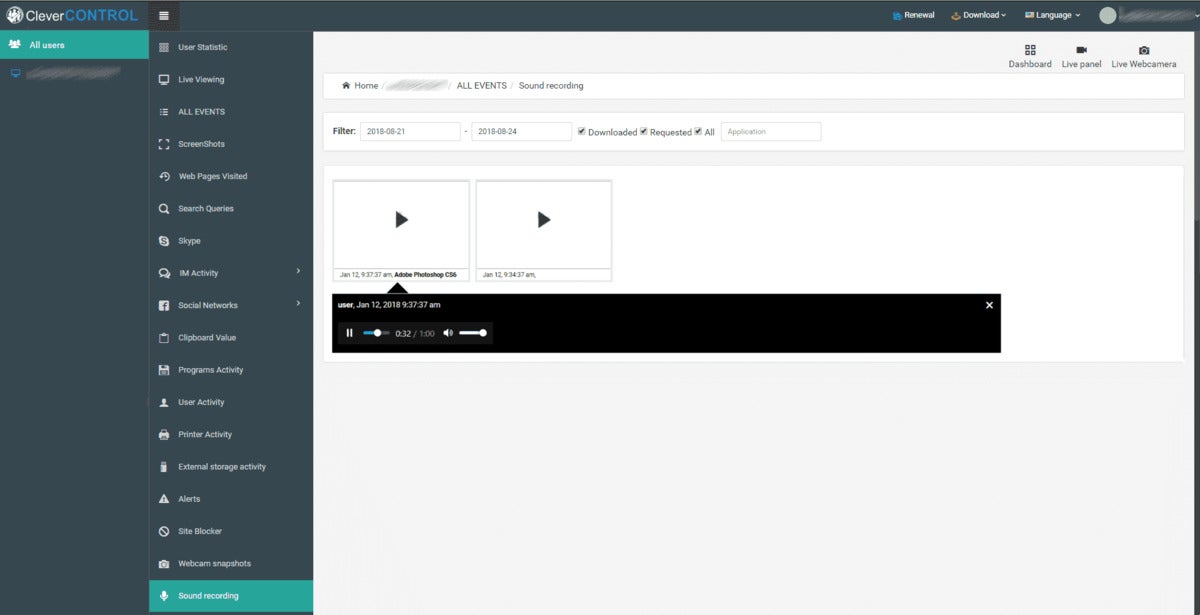 ClverControl
ClverControl
With CleverControl’s software, admins can record audio from an employee’s microphone and speakers to monitor conversations during a call.
“In the last couple of years, we've seen [monitoring] go one step further, where there's software that you can install on your employees’ laptops,” said Kropp.
“They track the speed at which [employees] type, can take pictures of you with your camera on your laptop, and can then align all of that data to get a sense of: Are you really as productive as you were? Are you slowing down? Are you exhausted? Are you burnt out? All sorts of metrics from that perspective.”
Productivity tracking is just one rationale for using monitoring software. Software vendors also argue that their tools can be used for insider threat detection, with the ability to automatically notify admins or managers about potentially malicious activity and anomalous behavior.
But measuring productivity is a key priority.
Though capabilities differ between products, all enable granular tracking of employee actions across a laptop, PC and often mobile devices. Common features include:
- Activity monitoring of websites and applications, with admin alerts for banned sites or apps
- Analytics dashboards that provide an overview of where time has been spent and whether it is productive or unproductive
- Regular screenshots and continuous video recording
- Recording of audio from a device’s speakers and microphone
- Keystroke logging to track every individual keystroke across any software application
- History logs and video playback
One company offering monitoring and analytics, Austin, TX-based ActivTrak, bills itself as a less-intrusive alternative to other monitoring tools, with a focus on individual and team workforce analytics. Founded in 2012, ActivTrak features granular data reporting and can collect automated screenshots. But it forgoes more invasive capabilities such as keystroke logging and live video recording.
“We look at our offering as a workforce analytics and productivity management platform,” said ActivTrak CEO Rita Selvaggi. “It gives both employees and employers an opportunity to see how work is done and improve the processes to get that work done.”
The company looks to provide customers with a data-backed overview of employee performance, said Selvaggi, identifying process bottlenecks and drawing a clear picture of how work gets done. The ActivTrak agent can be installed on an employee’s computing device, reporting data gathered back to servers hosted in Google’s cloud. Data insights are viewable by managers and team members, with a “team pulse” feature providing a daily summary of which team members are the most productive.
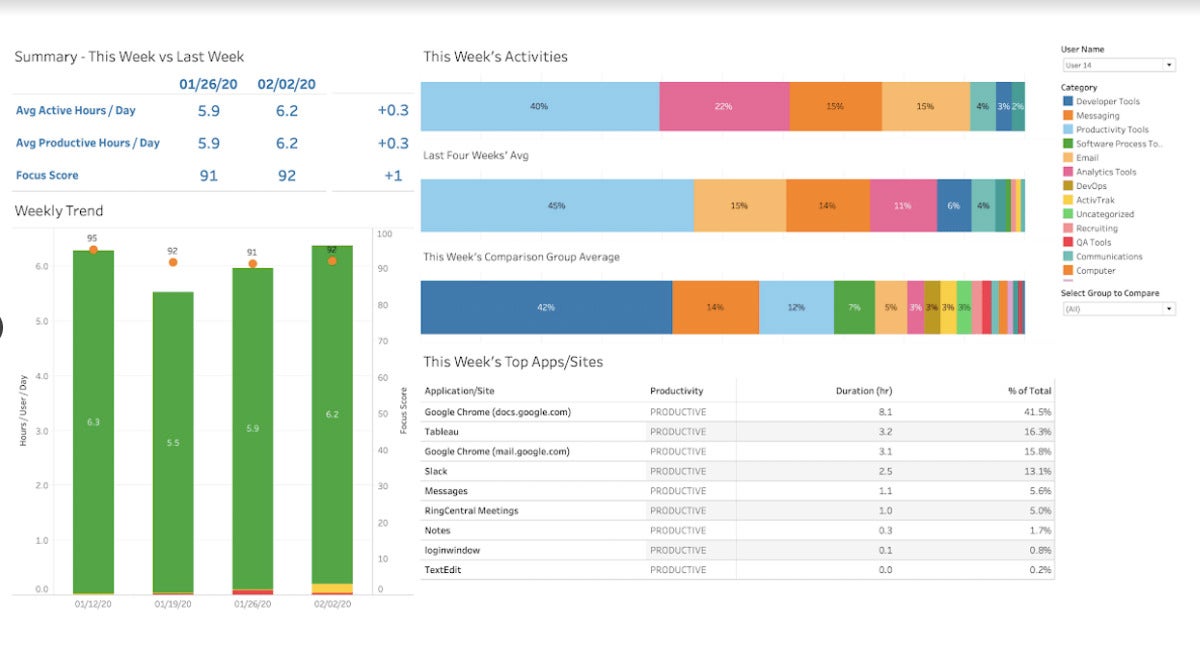 ActivTrack
ActivTrack
ActivTrack customer York International uses the Data Connect feature to send user data to Microsoft’s PowerBI visualization tool, offering senior leaders a snapshot of workforce productivity.
ActivTrak also integrates with external business intelligence providers, with its Data Connect platform letting customers export data to PowerBI, for example, or correlate ActivTrak data with CRM or HR platforms for deeper analysis. Doing so can identify best practices among top-performing workers, said Selvaggi.
“We believe that the value of what we can bring to customers is in the data,” she said. “By understanding insights about how employees work, you can derive improvements in productivity, you can actually make work more enriching — all of those types of side benefits from using the data.”
The software should be used to support workers, not control them via intrusive monitoring, she argued. “As long as you have these guiding principles on how that data is to be used, it shapes the value of the platform,” Selvaggi said. “Insight versus oversight is an important mantra for us; data should be insightful, and it should not necessarily be used for oversight or monitoring alone.”
With that in mind, Selvaggi said the company proactively works with customers to consider their use of employee data before rolling the platform out. “We have expanded our onboarding team so that our team has very deliberate walkthroughs with new customers to take them through: ‘How do you roll out the product? How do you look at the data? How do you organize the data? How do you bring employees into the conversation?’ — all of those things,” said Selvaggi. “We expect that to continue and grow in the coming year, because we think there’s huge opportunity for managers to be better enabled as coaches with employees, leveraging the data for that purpose.”
Increased use of monitoring during the pandemic
With so many employees required to work from home due to the Covid-19 pandemic, monitoring tools have seen a significant increase in adoption.
“Organizations are trying to understand: are employees working remotely actually working or not?” said Kropp. “One of the biggest fears that companies had as employees moved remote is ‘are employees going to work or are they going to be to sit on their couch and watch TV and eat pizza all day?’ That's why they've really pushed down this path of new employee monitoring software for the remote workforce nowadays.”
Selvaggi notes an uptick in demand for ActivTrak’s software, which has about 6,500 customers, as a result of the pandemic.
 ActivTrak
ActivTrak
ActivTrak CEO Rita Selvaggi.
“It's been significant. Demand dramatically increased in the March-April timeframe when the pandemic mandated remote work,” said Selvaggi. “As a result of that, we did see a large influx — and continue to see a large influx — of new customers and lots of expansion with existing customers to accommodate the remote work mandate.”
Other monitoring app vendors have seen the same thing. Time Doctor, for example, claims to have a total of 83,000 subscribers, while HubStaff and Awareness Technologies have both claimed demand has tripled since the pandemic. Even before the pandemic, analyst firm Market Research Future had predicted that the market for employee monitoring software in various forms would be worth $3.84 billion by 2023, though it warned that data privacy concerns could curb growth.
Demand for employee monitoring and performance analytics isn’t limited to remote work, said Selvaggi. With the proportion of knowledge workers in the overall workforce growing, and with an ever-greater reliance on digital tools to get work done, employee monitoring isn’t likely to go away with a return to the office.
“Actually, I don't think this just a remote-work thing,” she said. “The remote work phenomenon has shone a light on a problem, which we've had with the digital transformation of work for a long time. We've had sort of a false sense of how work gets done, or we look at it in pockets.
“Every collaboration tool can tell you that people are driving outputs, or they're communicating with others on your team. But what you don't have is this whole picture of your day. How do interruptions happen? How does that impede progress against goals?
“The pandemic served as a useful wake-up call for all of the folks who do digital work today... The tone of the conversations has moved from solely, 'I want to see what people are doing,' to, 'I want to see how people are working,' and how we can work together to make this new reality — which might [continue] for some time — better for both.”
Why use employee monitoring tools?
York International, an employee-owned insurance brokerage firm in Westchester County, New York, deployed ActivTrak’s software as a remote work pilot project around a year ago.
By tracking productivity levels, the company hoped the software would address concerns of senior leaders at York about people working outside of the office. In some respects, it offered a trade-off: by providing greater insight into working behaviors, ActivTrak made it possible for the company to offer employees more freedom and flexibility in their working lives.
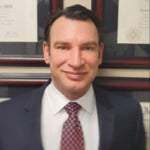 York International
York International
Myles Block, chief operating officer at York International.
“There was some skepticism [around remote working] just because it’s an unknown,” said Myles Block, chief operating officer at York International. ActivTrak’s software “built a level of trust.”
“It was a very early proof-of-concept that [showed] people do work at home; they're not sitting by their pool or at their vacation house, they are doing work. It was a benefit for everybody.”
This year, the app was put to wider use, tracking productivity as all 50 York International employees were forced to work from home due to social-distancing measures.
Block said it can provide an overview of productivity and help employees stay productive outside of the office. “We saw this as a huge opportunity, not just for us as the management team, but for the employees themselves,” he said. “Anything we can do to make them more efficient and more productive, and identify the tasks that they're better at, helps the company — and it helps the employee, too.”
Detailed monitoring of employee actions was not behind the deployment, said Block. “If we did that, even for a mid-sized company like ours, we would need two or three full-time people looking at that granular data. That's not the way we want to be using this. I personally don't feel like it's the right way to use it.
“Nobody wants Big Brother watching them,” Block said, “so there's got to be a certain level of trust, and I do believe we have that with our employees.”
While the tracking data can help uncover team or individual productivity issues, it’s not a replacement for human perception and judgement, said Block.
“There could be dozens of explanations for why somebody is ‘idle’ [on their device]. And again, that comes to the other parts of the equation that you’ve got to evaluate: What are the hard deliverables? Are they meeting their deadlines? What is the quality of their work?
“That's something you still need some managerial judgement for; I think anybody looking to use the software as just a red or green indicator of whether somebody is productive is kind of missing the boat.”
Looking ahead, York International plans to continue to use the tool when staff return to the office. “The proof-of-concept can carry on after we progressed through this crisis into whatever our remote strategy is going forward,” he said.
“I would be very shocked if we made the decision to go back five days a week for everybody in the future... “We're going to be able to make better decisions about what that remote strategy looks like.”
Ultimately, transparency is key, Block said, because the organization is co-owned by its staff.
“We are hyper transparent about everything [such as] our financials. We feel like that's an important part of the employee culture because we're not just teammates, we're co-owners.
“People want that accountability,” Block said. “People want that transparency. I think the responsible employee, whether it's an employee-owned company or not, they want to be held accountable. People were very willing to [provide transparency] because they know they're working, they know they're productive at home, and they want to prove that.”
Worker discomfort with monitoring software
For many employees, however, closely tracking their activities via monitoring software raises red flags.
A survey of 1,800 workers by UK union Prospect indicated that nearly 80% of respondents would be “uncomfortable” with camera-monitoring technology and 66% would be leery of keystroke monitoring.
That level of discomfort could affect employee trust: almost half (48%) said the use of monitoring software would damage their relationship with their manager — a figure that rose to 62% among workers 18 to 24 years old.
“The vast majority of workers are really uncomfortable with the idea of this level of software intrusion coming into our homes or to our laptops,” said Andrew Pakes, director of communication and research at Prospect. “It's a level of intrusion we haven't seen before, particularly in white-collar type jobs.
 Prospect
Prospect
Andrew Pakes, director of communication and research at Prospect.
“We risk sleepwalking into a massive extension of surveillance software into our homes, into our private spaces, in the name of tackling a public health need — but without the discussion about what the other consequences of that are,” Pakes said.
Increased monitoring could put more pressure on employees at a time when they may be balancing work commitments with looking after family while working from home. “This is another thing that can add stress to people,” said Edgar Ndjatou, executive director of Workplace Fairness, a Washington, DC-based worker rights advocacy group.
Businesses that that use granular monitoring tools without informing workers risk a backlash from employees as well as negative publicity. In the US, it is legal to monitor employees without consent in all states except Connecticut and Delaware. In the UK and countries subject to Europe’s GDPR rules, employers have a requirement to notify the “data subject” — in this case, the employee.
In fact, multinational bank Barclays is under investigation by UK regulators over allegations that it used software from Sapience Analytics to monitor individual workers without their knowledge — a move described by a UK union as “dystopian Big Brother tactics.” The lender had previously been criticized for the installation of heat sensors to detect whether staff were at their desks.
“The place where this is hugely problematic is that if you're tracking and monitoring your employees, but your employees don't know that you're doing it,” said Gartner’s Kropp. “That's where you get a lot of employee pushback and resentment and frustration, and anger and accusations of being unethical.”
Transparency means employee consultation
Transparency around any form of monitoring is key, said Kropp. He recommends companies create an “employee ethical Bill of Rights” that governs the use of employee data, drawing clear lines around what is collected and measured, and to have in place such rules among core company values.
Employees are much more comfortable with monitoring if a company explains how and why it’s being done. Gartner research indicates that around 75% of those surveyed were okay with monitoring when consulted. In contrast, only around one in four thought it ethical for companies to collect information without their knowledge.
That echoes Prospect’s survey, which indicates that consultation with workers prior to deployment could reduce apprehension. Around one third (32%) of remote workers said they’d be more comfortable with monitoring software if trade unions or worker representatives were consulted first.
Moore, in her proposal to the EU Parliament, recommends that businesses consult with employees and their representatives to discuss what level of monitoring is appropriate — a process of co-determination. This ensures that the needs of employees are factored in from the very start of any decision to deploy monitoring tools.
“The design of all systems should be directly negotiated as well as practically developed with worker representatives,” she said. “There should be experts within union and worker council groups that work alongside management to co-determine and co-design and collaborate — and roll out collaboratively — so that there can be a form of consent.”
Ndjatou concurs: “If you're going to use this type of software, at least get employee buy-in first. Have an employee or two represented at the table, so they know about the technology, why it's being used, what information is stored or retrieved, for what purpose, and how long it is stored.”
"Communicate, have a plan, engage with employees on the data,” said Selvaggi. “Don’t just tell them what’s happening — get their feedback, get their input, have employees work with the employer on the value of what they’re seeing. From that, you’ll see far more benefits in terms of the outputs that you want over time. You’ll probably learn a whole heck of a lot about your employees, your managers and the apps that you spend money on.”
Determining what constitutes real employee consent can be more problematic than it seems. Workers may feel pressured to comply with the company plans, particularly during a time of upheaval and uncertainty.
“When you ask a worker to consent to be tracked and monitored, you have to ask the question: is it meaningful consent, given the unbalanced relationship between the worker and the manager?” said Moore. “Where [meaningful consent] may not always be possible, there should at least be co-determination; there should be collective discussion.”
“In the work relationship, it is a power relationship,” said Pakes. “And if your employer says this needs to happen, then ‘consent’ is slightly different.”
In many cases, employee productivity can be effectively tracked and monitored without the need for monitoring tools, said Moore. “If it's project-based work, then clearly the proof is in the pudding; if you finished your project on time, I'm not going to start asking you to clock in and clock out every five seconds. It's your responsibility.”
“There are many things you can do that don't require the use of surveillance technology,” said Ndjatou, who suggests managers increase check-ins with workers and set clear expectations for productivity directly.
The use of monitoring tools should be limited — or avoided altogether — when less-invasive methods of tracking will do, Pakes said.
“Do you need the technology in the first place? And if you need some of it, do you need all of it? There needs to be a better understanding of what your KPIs are, what performance you trying to measure, what outcomes you're trying to achieve, and have that conversation with your workforce.
“That will build much better social partnership at work in terms of what... you expect people to deliver.”
"work" - Google News
October 29, 2020 at 05:00PM
https://ift.tt/34F5VDf
The New Normal: When work-from-home means the boss is watching - Computerworld
"work" - Google News
https://ift.tt/3bUEaYA
Bagikan Berita Ini














0 Response to "The New Normal: When work-from-home means the boss is watching - Computerworld"
Post a Comment